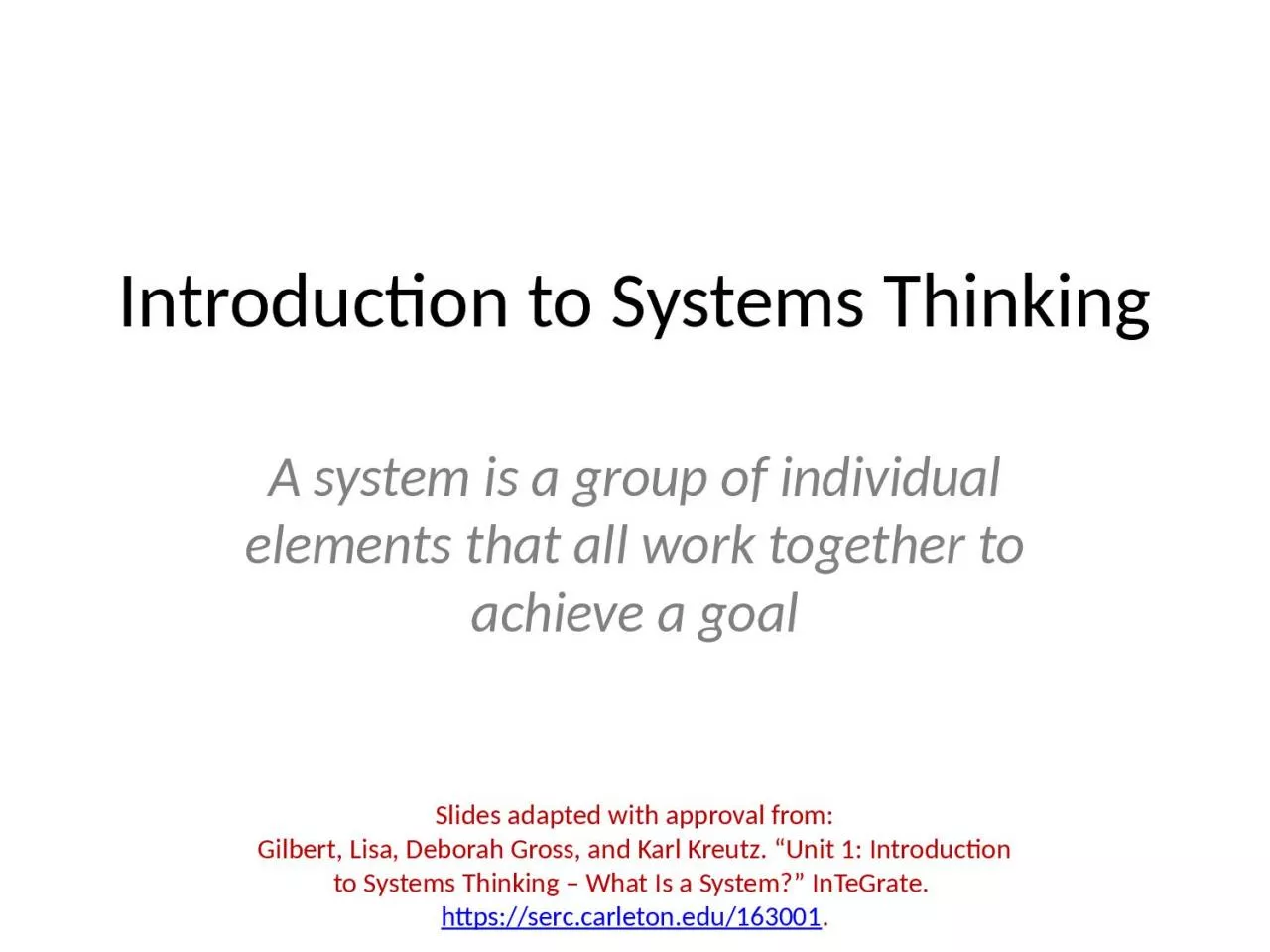

A system is a group of individual elements that all work together to achieve a goal Slides adapted with approval from Gilbert Lisa Deborah Gross and Karl Kreutz Unit 1 Introduction to Systems Thinking What Is a System InTeGrate ID: 932135
Download Presentation The PPT/PDF document "Introduction to Systems Thinking" is the property of its rightful owner. Permission is granted to download and print the materials on this web site for personal, non-commercial use only, and to display it on your personal computer provided you do not modify the materials and that you retain all copyright notices contained in the materials. By downloading content from our website, you accept the terms of this agreement.
Slide1
Introduction to Systems Thinking
A system is a group of individual elements that all work together to achieve a goal
Slides
adapted with approval from:
Gilbert, Lisa, Deborah Gross, and Karl Kreutz. “Unit 1: Introduction to Systems Thinking – What Is a System?” InTeGrate.
https://serc.carleton.edu/163001
.
Slide2Goals
:Define Systems Thinking VocabularyRead and interpret simple systems diagrams.Apply systems thinking vocabulary to real world examples
Introduction to Systems Thinking
Slide3Go to the
“Describe a Sink”
Google Slide in our class folder
Slide4Water in sink
faucet
drain
Here is my simple sink:
Let’s define some systems vocabulary.
Type the sink system examples for each vocabulary term in the example text boxes in Section A on the handout.
Slide5Water in sink
faucet
drain
Here is my simple sink:
The faucet, sink, and drain are all ‘parts’ or ‘
elements
’ of the sink system
Slide6Here is my simple sink:
T
h
is sink is a
System
:
A group of individual elements that all work together to achieve a goal
Water in sink
faucet
drain
Slide7The water in the sink is a reservoir
Reservoir
A place where ‘things’ t
ha
t move through a system are stored
‘Things’ = people, ideas, objects, feelings, electricity, etcetera
Water in sink
faucet
drain
Slide8The water in the sink is a reservoir
Reservoir
We measure the
Quantity
, or amount, of ‘things’ in a reservoir
For example:
- The volume of water in a sink
Water in sink
faucet
drain
Slide9Flow
The rate (how fast) things move between reservoirs
The faucet represents a flow
Water in sink
faucet
drain
Slide10Flow
Flow Rate =
Quantity
Time
The faucet represents a flow
Water in sink
faucet
drain
For example:
The
rate
water flows into the sink =
Volume of water
Time
Slide11We can measure the rate at which water
drains out of the sink
Flow
The drain also represents a flow
Water in sink
faucet
drain
Volume of water
Time
Slide12Water in sink
faucet
drain
What reservoirs is this water coming from and going to?
Slide13Water in sink
faucet
drain
What reservoirs is this water coming from and going to?
Water in hot water heater
Pipes to sewer
This is called a closed system, because the diagram begins and ends with reservoirs
Slide14Water in sink
faucet
drain
Event
Causes the flows in a system to change
When we turn on or off the faucet, we change the rate water flows into the sink
Water in hot water heater
Pipes to sewer
turn on/off
the faucet (+)
Slide15Pipes to sewer
Water in sink
faucet
drain
Event
Water in hot water heater
causes the system to change
When we turn on or off the faucet, we change the rate water flows into the sink
turn on/off
the faucet (+)
+
= Same Relationship
Increase flow rate
Increase water in reservoir
Decrease flow rate
Decrease water in reservoir
Slide16Water in sink
faucet
drain
Event
What other event could change the system?
Water in hot water heater
Pipes to sewer
turn on/off
the faucet (+)
causes the system to change
When we turn on or off the faucet, we change the rate water flows into the sink
Slide17Water in sink
faucet
drain
Event
Water in hot water heater
Pipes to sewer
turn on/off
the faucet (+)
Plug/unplug the drain (-)
causes the system to change
When we turn on or off the faucet, we change the rate water flows into the sink
Slide18Water in sink
faucet
drain
Event
Water in hot water heater
Pipes to sewer
turn on/off
the faucet (∆)
causes the system to change
When we turn on or off the faucet, we
-
= Opposite Relationship
Decrease flow rate
Increase water in sink reservoir
Increase flow rate
Decrease water in sink reservoir
Plug/unplug the drain (-)
Slide19Systems Thinking for Complex Problems
Psst…Not all systems are this simple!
But, by breaking complex systems down into manageable elements (flows, reservoirs, events), we can better understand and
visualize
complex systems
Slide20Let’s Brainstorm…
Comment your ideas in our zoom chat or raise your hand to offer an idea!
What are other examples of systems?
Slide21Based on our brainstorming…
Add examples of different
systems, reservoirs, flows, and events
in the example text boxes in Section A
Flow of ideas!